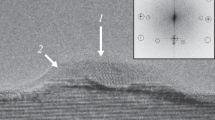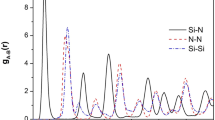Abstract
Structural features have been identified for microcrystalline silicon carbide (µc-SiC), and also for the amorphous analog (a-SiC) within the framework of molecular dynamics by the use of the empirical Tersoff potential. Detailed analyses have been performed for µc-SiC on the crystallite, grain boundaries, and amorphous matrix. The amorphous matrix in µc-SiC is more ordered than the amorphous structure in a-SiC. Careful studies have been made of the state densities in the two materials on the basis of an sp3s* tight-binding scheme. A possible mechanism has been proposed for the effects of homopolar bonds and other coordination defects on the electronic states and cohesion. The results are compared with those obtained by other researchers.
Similar content being viewed by others
REFERENCES
Y. Hamakawa, “A technological evolution from bulk crystalline age to multilayer thin film age in solar photovoltaics,” Renewable Energy, 15, 22–31 (1998).
U. Schmid, M. Eickhoff, Ch. Richter, et al., “Etching characteristics and mechanical properties of a-SiC:H films,” Sensors and Actuators, A94, 87–94 (2001).
L. Calcagno, A. Hallen, R. Martins, and W. Skorupa, Amorphous and Crystalline Silicon Carbide: Materials and Applications, Elsevier, Amsterdam (2001).
F. Finocchi, G. Galli, M. Parrinello, and C. M. Bertoni, “Microscopic structure of amorphous covalent alloys probed by ab initio molecular dynamics: SiC,” Phys. Rev. Lett., 68, 3044–3047 (1992).
P. C. Kelires, “Short-range order and energetics of disordered silicon-carbide alloys,” Phys. Rev. B, 46, 10048–10061 (1992).
P. C. Kelires and P. J. H. Denteneer, “Theory of electronic properties of amorphous silicon-carbon alloys: Effects of short-range disorder,” Solid State Comm., 87, 851–855 (1993).
J. Tersoff, “Chemical order in amorphous silicon carbide,” Phys. Rev. B, 49, 16349–16352 (1994).
V. I. Ivashchenko and V. I. Shevchenko, “Effects of short-range disorder upon electronic properties of a-SiC alloys,” Appl. Surf. Sci., 184, 137–143 (2001).
P. Vogl, H. P. Hjalmarson, and J. D. Dow, “A semi-empirical tight-binding theory of the electronic structure of semiconductors,” J. Phys. Chem. Sol., 44, 365–378 (1983).
P. C. Kelires, “Structural properties of amorphous form of carbon,” Phys. Rev. B, 47, 1829–1839 (1993).
Author information
Authors and Affiliations
Additional information
Translated from Poroshkovaya Metallurgiya, No. 9–10(439), pp. 94–99, September–October, 2004.
Deceased.
Rights and permissions
About this article
Cite this article
Ivashchenko, V.I., Shevchenko, V.I., Ivashchenko, L.A. et al. The atomic pattern and electron structure of amorphous and microcrystalline sic. Powder Metall Met Ceram 43, 520–524 (2004). https://doi.org/10.1007/s11106-005-0015-4
Received:
Issue Date:
DOI: https://doi.org/10.1007/s11106-005-0015-4




